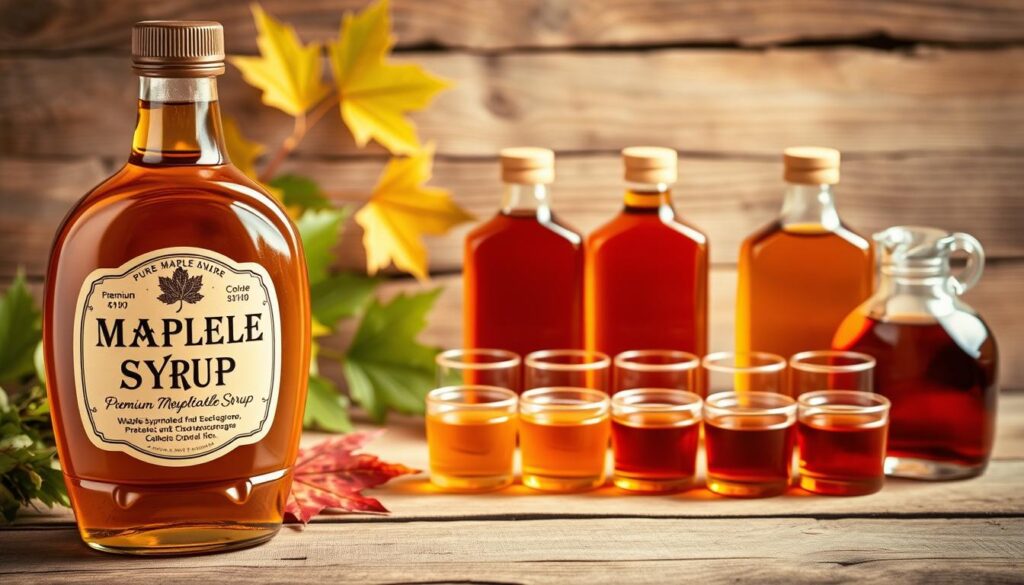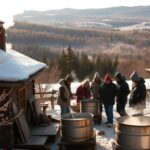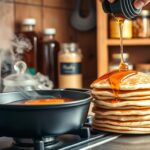Discovering authentic maple syrup can change how you cook. This golden nectar comes from maple trees in North America. It’s a tradition of natural sweetness and craftsmanship.
Maple syrup making is a skill passed down through generations. People in Vermont, New Hampshire, and Quebec work hard to make it. They turn tree sap into a premium condiment, unlike artificial ones.
Finding the best maple syrup is more than just picking a bottle. You need to know about its origin, how it’s made, and its flavor. Sugarmakers work hard for months to make this unique sweetener.
This guide will teach you about choosing the best maple syrup. You’ll learn about production methods and where to find authentic syrup. You’ll understand why maple syrup is special and how to spot the real thing.
Exploring maple syrup is an adventure for food lovers. It’s about taste, tradition, and quality craftsmanship. Finding real maple syrup is a journey worth taking.
Understanding Real vs. Artificial Maple Syrup
It’s important to know the difference between real and fake maple syrup. This is key for finding the best maple syrup. Real maple syrup has a unique taste and health benefits that fake syrup can’t match.
Chemical Composition Differences
Real maple syrup has a mix of natural compounds that fake syrup can’t copy. When looking for maple syrup, knowing these differences is essential:
- Real maple syrup is made from pure tree sap with natural sugars
- It has important minerals like calcium, potassium, and zinc
- It’s made using traditional boiling methods
Natural vs. Artificial Flavoring Components
The taste of real maple syrup comes from natural processes. Synthetic syrups use chemical additives that can’t match the real thing’s depth and complexity.
Health Benefits Comparison
Choosing real maple syrup has big health benefits:
- It has a lower glycemic index than artificial sweeteners
- It’s full of antioxidants
- It has trace minerals that are good for your health
Real maple syrup is a pure, unprocessed natural sweetener with real nutritional value.
The Maple Syrup Production Process
Farm fresh maple syrup starts with a careful balance between nature and skilled producers. The process is a tradition that turns tree sap into golden syrup. It’s done with great care and skill.
Maple tree tapping needs the right timing and knowledge. Producers pick trees that are at least 40 years old and 10 inches wide. The best time to collect sap is late winter to early spring, when it’s cold at night and warm during the day.
- Ideal tapping season runs from February to March
- Trees must be healthy and mature
- Each tree can support multiple taps
The sap collection process has several important steps:
- Drilling small holes into maple tree bark
- Inserting collection spouts
- Connecting tubing systems or hanging traditional metal buckets
- Gathering raw sap
| Production Stage | Key Details | Time Required |
|---|---|---|
| Sap Collection | 40:1 sap to syrup ratio | 2-4 weeks |
| Boiling | Reduce sap in evaporator | 4-6 hours |
| Filtering | Remove mineral deposits | 1-2 hours |
Modern maple syrup producers use advanced technology like reverse osmosis machines. This makes the boiling process faster and uses less energy. It keeps the syrup’s authentic flavor.
The last step is filtering and bottling the syrup at the right temperature. This ensures that the maple syrup is of the highest quality and taste when it reaches consumers.
Grading Systems and Quality Standards
Knowing about maple syrup grades is key for making smart choices. It tells you about the syrup’s quality, color, and taste. This info is vital when buying pure maple syrup.
USDA Grading Categories
The USDA created a grading system for maple syrup. It ensures quality is consistent. Here are the main categories:
- Golden Color, Delicate Taste: Lightest grade with mild flavor
- Amber Color, Rich Taste: Slightly deeper color with more pronounced maple flavor
- Dark Color, Robust Taste: Stronger maple flavor with deeper color
- Very Dark Color, Strong Taste: Most intense maple flavor
Canadian Grading Standards
Canada’s maple syrup grading is similar but has its own terms. It focuses on light transmission and flavor. This ensures top-notch syrup quality.
Color and Flavor Profiles
The syrup’s color shows its flavor strength. Lighter syrups are sweeter, while darker ones have deeper maple flavors. Each grade is special for different recipes.
When looking for real maple syrup, knowing these grades is important. It helps you pick the right syrup for your taste and cooking needs.
Where Can I Get Real Maple Syrup
Finding real maple syrup means knowing where to look. Local stores and farmers’ markets are great places to find it. They connect you with producers who make syrup the old way.
Here are the best places to buy real maple syrup:
- Farmers’ markets with local maple producers
- Specialty food stores and gourmet shops
- Direct farm purchases in maple-producing regions
- Reliable online marketplaces specializing in artisan foods
Buying from a local store has many benefits. Buyers can taste different types and learn how it’s made. They also support local farmers.
“Real maple syrup isn’t just a condiment – it’s a craft passed down through generations of sugarmakers.”
Online shopping has also become easier. Websites from farms in Vermont, New Hampshire, and Quebec ship syrup to you. Some even offer subscription services for fresh syrup.
- Check producer certifications
- Read customer reviews
- Verify the syrup’s origin
- Compare price and quality
Before you buy, ask about the syrup’s season, how it’s made, and its grade. A good store will tell you all about it, helping you choose wisely.
Seasonal Considerations When Buying Maple Syrup
Knowing when maple syrup is made can help you pick the best syrup. The process is a careful mix of nature and the skill of sugarmakers. The right time is key to getting syrup’s sweetest flavor.
Peak Harvesting Times
Maple syrup is made for a short time each year, usually from late February to early April. The best sap flow happens when:
- Daytime temperatures are above 40°F
- Nighttime temperatures are below freezing
- There are specific regional climate conditions
Best Times to Purchase
Looking for organic maple syrup? Here’s what to do:
- Buy it right after the spring harvest for the best taste
- Go to local farmers markets during maple season
- Get in touch with regional sugarhouses for the best harvest times
Storage Duration Guidelines
Storing syrup right keeps its quality top-notch. Unopened maple syrup can last forever in a cool, dark spot. After opening, keep it in the fridge to keep the flavor and stop crystals from forming.
Pro tip: Always check the packaging date to ensure maximum freshness!
By knowing these seasonal tips, maple syrup lovers can enjoy the best syrup all year.
Price Points and Value Considerations
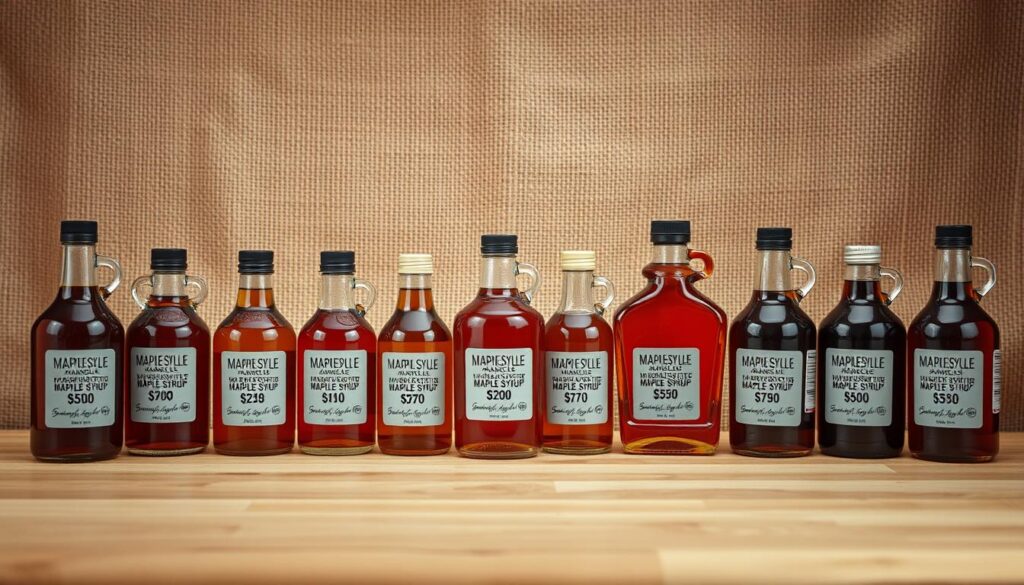
Understanding the price of pure maple syrup involves knowing its unique production. The effort put into each bottle makes it a premium choice. It’s perfect for those looking for the best maple syrup.
Several key factors influence maple syrup pricing:
- Labor-intensive harvesting methods
- Limited seasonal production
- Extensive sap collection requirements
- Quality grading distinctions
Maple syrup prices vary based on several important factors:
| Pricing Factor | Price Impact |
|---|---|
| Grade Quality | $8 – $25 per 16 oz |
| Production Source | $10 – $30 per bottle |
| Organic Certification | $15 – $35 per bottle |
Local artisan producers often command higher prices due to small-batch production and superior quality. Consumers should look at maple syrup’s flavor and production methods, not just the price.
True maple syrup represents a culinary investment in tradition and craftsmanship.
When looking for pure maple syrup, consider buying directly from farms or gourmet stores. These places offer authentic and high-quality syrup. They ensure a great maple syrup experience.
Supporting Local Maple Syrup Producers
Buying from local maple syrup producers connects us to old farming ways. These small producers offer unique tastes and eco-friendly farming that big brands can’t. They keep the tradition alive.
Shopping at a local maple syrup store helps both buyers and rural areas. These farmers keep old farming methods alive. They also give top-notch syrup right to us.
Farm Direct Advantages
- Experience fresher, more authentic maple syrup
- Access unique, small-batch varieties
- Learn about traditional maple syrup production methods
- Support sustainable agricultural practices
Community Economic Impact
Buying from maple syrup producers helps local economies grow. These small businesses keep rural areas thriving. They also protect our farming heritage.
“Supporting local producers isn’t just about buying syrup—it’s about maintaining a cultural legacy.”
People can meet local maple syrup producers at farmers markets and local events. Every purchase supports sustainable food systems and our communities.
Organic vs. Conventional Maple Syrup
Maple syrup fans looking for organic options are curious about the differences. The journey from forest to table shows how organic and conventional syrups differ. These differences affect taste, quality, and how good they are for the environment.
Real maple syrup suppliers highlight important differences between organic and conventional syrup:
- Chemical-free forest management
- Strict certification standards
- Environmental conservation practices
- Minimal processing techniques
Organic maple syrup production is strict. Sugarmakers must keep forests healthy without using synthetic pesticides or chemicals. This helps the environment and keeps maple trees healthy.
“Organic maple syrup represents not just a product, but a commitment to sustainable agriculture and forest preservation.” – Maple Farming Association
Buying organic maple syrup has benefits for you:
- Less chemical exposure
- Better natural taste
- Supports eco-friendly farming
- More nutrients
When searching for organic maple syrup, look for the USDA Organic label. It shows the syrup meets high standards. These standards protect both you and the forest.
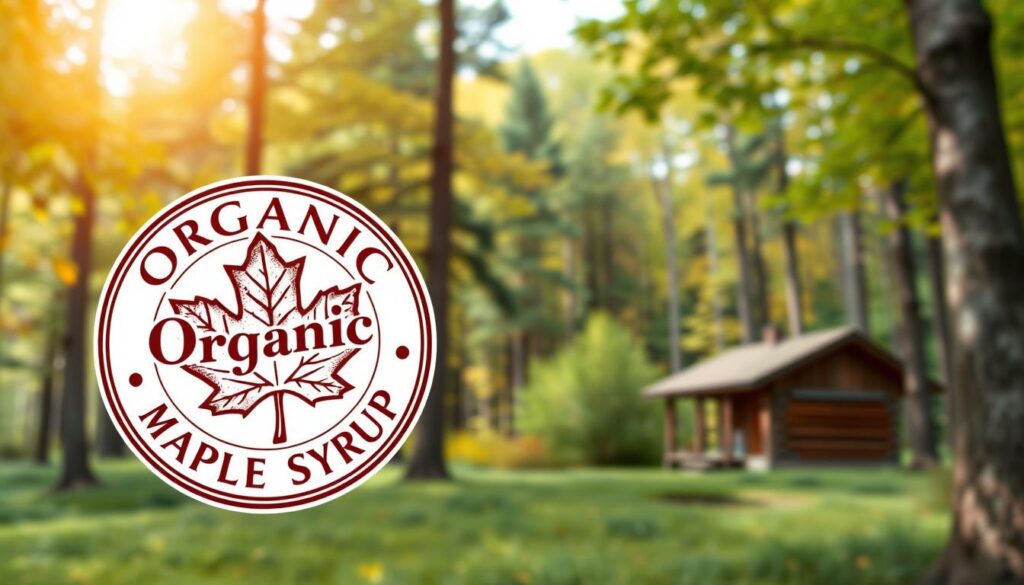
Organic maple syrup might be pricier, but it’s worth it. It supports green production and gives you a cleaner, more natural syrup.
Proper Storage and Preservation Methods
Keeping pure maple syrup fresh requires careful storage and preservation. Sugarmakers and maple syrup fans know that handling it right can make it last longer. This natural sweetener is a treat to enjoy.
Temperature Requirements for Optimal Preservation
Temperature is key to keeping maple syrup quality high. Store unopened syrup in a cool, dark place. Once opened, it needs to be refrigerated.
- Unopened syrup: Store at room temperature (50-70°F)
- Opened syrup: Refrigerate at 35-40°F
- Avoid direct sunlight and heat sources
Selecting the Right Container
The right container is important for syrup preservation. Glass and food-grade plastic containers with tight lids are best.
- Glass bottles with airtight lids
- Food-grade plastic containers
- Avoid metal containers that might interact with syrup
Understanding Shelf Life Expectations
Maple syrup stored right can stay great for a long time. Unopened syrup can last up to two years. Opened syrup stays fresh for months when refrigerated.
- Unopened: Up to 2 years
- Opened and refrigerated: 6-12 months
- Check for signs of mold or off-odors before consumption
“Treat your maple syrup like a fine wine – with care and respect.” – Maple Syrup Preservation Expert
Online Purchasing Options and Reviews
Buying maple syrup online is now easier for those who love syrup. It’s all about finding top-notch products. To buy maple syrup online well, you need to know a few things.
Finding the best maple syrup online takes some work. Look for trusted sites and direct from producers. These places offer unique maple syrup varieties.
- Verified online maple syrup retailers
- Direct farm websites
- Specialty gourmet food platforms
- Artisan maple producer marketplaces
Expert tip: Always check customer reviews and product descriptions carefully before purchasing maple syrup online.
“Quality maple syrup is about authenticity, not just convenience” – Maple Syrup Artisan Association
When you buy maple syrup online, think about these important points:
- Detailed product descriptions
- Shipping policies
- Packaging quality
- Customer feedback ratings
- Authenticity verification
Many sites now share lots of info about their syrup. They talk about where it comes from, how it’s made, and its grade. This helps you choose wisely when buying online.
The best maple syrup isn’t just cheap. It’s about finding real, high-quality syrup from people who care. They use old ways to make syrup.
Maple Syrup Packaging Types
Choosing the right packaging for pure maple syrup is key to keeping it fresh. If you’re looking for real maple syrup, you’ll find different packaging options. These choices can affect how it tastes, how long it lasts, and your overall experience.
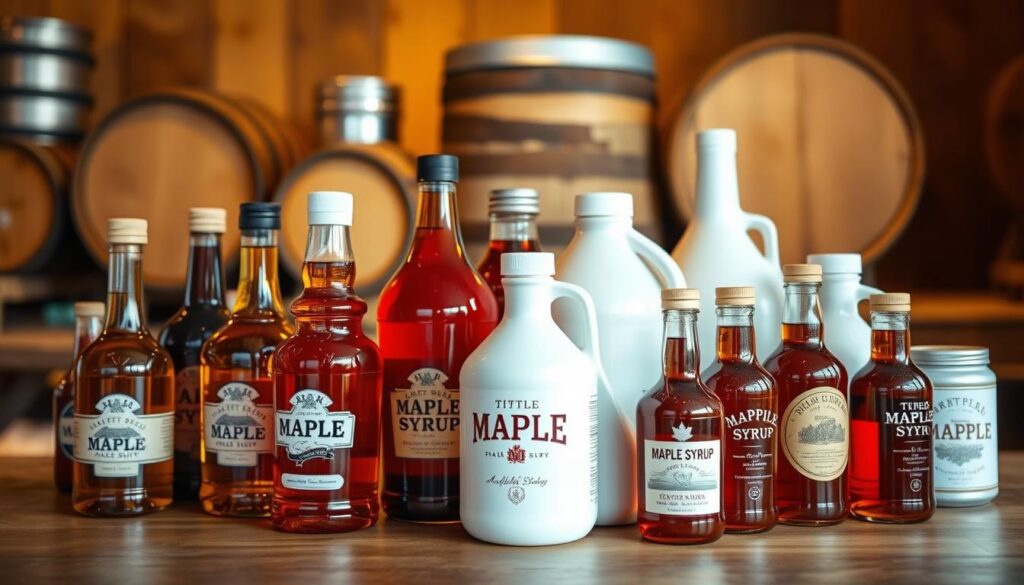
Glass vs. Plastic Containers
When you’re searching for real maple syrup, knowing about container types is important. Glass containers have many benefits:
- They help keep the syrup’s original flavor better.
- They don’t leach chemicals into the syrup.
- They’re better for the environment.
- They’re easy to clean and can be reused.
On the other hand, plastic containers are lighter and less likely to break. But, they might make the syrup taste less authentic over time.
Bulk Purchase Options
If you love maple syrup and want to buy it in bulk, there are several options:
| Container Size | Quantity | Cost Efficiency |
|---|---|---|
| Quart Jars | 32 fl oz | Moderate savings |
| Half-Gallon | 64 fl oz | Higher savings |
| Gallon Containers | 128 fl oz | Best value |
Pro tip: Buying in larger containers can save you money. It also reduces waste and is better for the environment.
Understanding Maple Syrup Certifications
Finding authentic maple syrup can be tricky. Different certifications help prove the syrup’s quality and where it comes from. These are important for maple syrup producers in North America.
Certifications tell us how the syrup was made. They help us choose the right syrup. These labels show the syrup is real, made in a sustainable way, and meets quality standards.
- Organic Certification: Confirms maple syrup is produced without synthetic chemicals or pesticides
- Kosher Certification: Validates production meets strict religious dietary guidelines
- Fair Trade Certification: Ensures ethical production practices and fair compensation for producers
Producers must pass tough inspections to get these certifications. Each one shows they care about quality, the environment, and traditional syrup making.
“Certifications are more than just labels—they’re a promise of quality and integrity in maple syrup production.”
To check if syrup is certified, look at the packaging. Official seals from known bodies are key. They tell us about the syrup’s origin, how it was made, and its quality.
Regional Variations in Maple Syrup
Maple syrup lovers know that not all syrups are the same. The taste of farm fresh maple syrup changes a lot from one place to another. This is because of the special bond between where it’s made and its flavor.
Looking into the world of maple syrup shows us many different tastes. Each local maple syrup store gives us a peek into the unique place that makes these sweet liquids special.
Northeast American Maple Syrup Characteristics
The Northeast United States has its own special maple syrup tastes:
- Vermont makes syrups that are light and have a hint of vanilla
- New Hampshire syrups are strong and caramel-like
- New York syrups have complex flavors with a hint of wood
Canadian Maple Syrup Varieties
Canada is known for its top-notch maple syrup. Each province has its own special taste:
| Province | Syrup Characteristics |
|---|---|
| Quebec | Rich, intense flavor with strong caramel notes |
| Ontario | Lighter, more delicate syrup with subtle mineral undertones |
| New Brunswick | Complex flavor profile with hints of butterscotch |
Climate, soil, and the type of tree all affect the taste of maple syrup.
Environmental Impact of Maple Syrup Production
Maple syrup producers are now focusing on ways to protect our forests. They use practices that are good for the environment. Making organic maple syrup near me means they care about the forest and its health.
Maple tree tapping is a special way to make syrup while keeping forests healthy. Producers use methods that help the forest stay strong. This way, they make syrup that is both tasty and of high quality.
- Responsible forest management practices
- Minimal tree impact during tapping
- Renewable energy use in sugar houses
- Climate adaptation strategies
Climate change is a big problem for maple syrup makers. Warmer winters and changing weather patterns mess up the syrup-making schedule. But, clever producers are finding new ways to keep making great syrup and protect the forest.
| Environmental Practice | Impact on Maple Syrup Production |
|---|---|
| Energy-efficient processing | Reduces carbon footprint |
| Selective tree tapping | Preserves forest ecosystem |
| Renewable energy utilization | Minimizes environmental stress |
Sustainable maple syrup production is not just about creating a delicious product—it’s about protecting our natural resources for future generations.
The future of maple syrup depends on our commitment to environmental stewardship and responsible forest management.
How to Verify Authentic Maple Syrup
Finding real maple syrup takes careful steps and knowledge. When looking for authentic maple syrup suppliers, it’s important to know how to spot the real thing. The market is full of imitations.
To find where to get real maple syrup, you need to learn about key verification techniques. These methods help tell real products from fake ones.
Essential Label Reading Techniques
Checking the label is the first step to see if maple syrup is real. Here are the important things to look for:
- Single ingredient: Pure maple syrup should list only maple syrup
- USDA grade designation
- Origin information specifying maple-producing regions
- Certification seals from maple producer associations
Authentication Methods for Maple Syrup
There are several ways to check if maple syrup is of good quality:
- Viscosity test: Pure maple syrup flows differently compared to artificial syrups
- Color examination: Authentic syrups have consistent, natural coloration
- Taste verification: Genuine maple syrup offers complex, nuanced flavor profiles
When searching for authentic maple syrup suppliers, look for local producers and specialty stores. These places focus on high-quality, traditional maple syrup.
Conclusion
Choosing authentic maple syrup is more than just a food choice. It’s about tradition, quality, and caring for the environment. Finding the best maple syrup means knowing about different production methods and quality standards.
For those looking for real maple syrup, local farmers markets and specialty stores are great places to start. You can also buy directly from farms. Online stores with trusted sources offer a wide range of authentic maple syrup from Vermont, New Hampshire, and Canada.
When buying maple syrup, look for grading systems and understand how it’s made. Genuine products are key. By choosing transparent and sustainable options, you connect with nature’s wonders.
Your journey with maple syrup is a discovery of flavors, traditions, and quality. Each bottle tells a story of hard work, family legacy, and caring for the earth. It’s not just a sweet treat, but a piece of cultural heritage.

